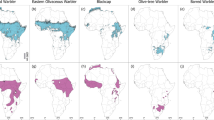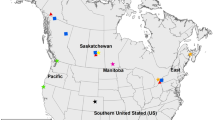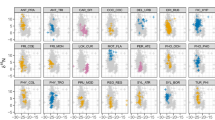Abstract
Conservation of migratory wildlife requires knowledge of migratory connectivity between breeding and non-breeding locations. Stable isotopes in combination with geographical isotopic patterns (isoscapes) can provide inferences about migratory connectivity. This study examines whether such an approach can be used to infer wintering areas in sub-Saharan Africa, where we lack such knowledge for many species, but where this method has not been used widely. We measured δ 2H, δ 13C and δ 15N in winter-grown feathers of a breeding Swiss and Spanish population of European hoopoe Upupa epops—a typical Palaearctic-Afrotropical migrant. δ 2H values predicted that ~70 % of the hoopoes spent the non-breeding season in the western portion of their potential winter range. This was corroborated by a shallow east–west gradient in feather-δ 2H values of museum specimens from known African origin across the potential winter range and by the recovery of Swiss hoopoes marked with geolocators. Hoopoes categorized as from eastern versus western regions of the wintering range were further delineated spatially using feather δ 13C and δ 15N. δ 15N showed no trend, whereas adults were more enriched in 13C in the western portion of the range, with eastern adults being in addition more depleted in 13C than eastern juveniles. This suggests that eastern juveniles may have occupied more xeric habitats than sympatric adults. We demonstrated that stable isotopes, especially δ 2H, could only very roughly delineate the winter distribution of a trans-Saharan Palaearctic migrant restricted primarily to the Sahelian and savanna belt south of the Sahara. Further refinements of precipitation isoscapes for Africa as well the development of isoscapes for δ 13C and δ 15N may improve assignment of this and other migrants.


Similar content being viewed by others
References
Africa Rainfall Estimate Climatology (CPC ARC) National Weather Service, Climate Prediction Center, National Oceanic and Atmospheric Administration (NOAA). http://www.cpc.ncep.noaa.gov/products/fews/AFR_CLIM/afr_clim.html, last accessed July 2011
Arlettaz R, Schaub M, Fournier J, Reichlin TS, Sierro A, Watson JEM, Braunisch V (2010) From publications to public actions: when conservation biologists bridge the gap between research and implementation. Bioscience 60:835–842
Bächler E, Hahn S, Schaub M, Arlettaz R, Jenni L, Fox JW, Afanasyev V, Liechti F (2010) Year-round tracking of small trans-Saharan migrants using light-level geolocators. PLoS One 5:e9566
Bensch S, Bengtsson G, Åkesson S (2006) Patterns of stable isotope signatures in willow warbler Phylloscopus trochilus feathers collected in Africa. J Avian Biol 37:323–330
Both C, Van Turnhout CAM, Bijlsma RG, Siepel H, Van Strien AJ, Foppen RPB (2010) Avian population consequences of climate change are most severe for long-distance migrants in seasonal habitats. Proc R Soc Lond B 277:1259–1266
Bowen GJ, Wassenaar LI, Hobson KA (2005) Application of stable hydrogen and oxygen isotopes to wildlife forensic investigations at global scales. Oecologia 143:337–348
Clark ID, Fritz P (1997) Environmental isotopes in hydrogeology. Lewis, New York
Cramp S (1985) Handbook of the Birds of Europe, the Middle East and North Africa. Oxford University Press, Oxford
Elgood JH, Fry CH, Dowsett RJ (1973) African migrants in Nigeria. Ibis 115:1–45
Evans KL, Waldron S, Bradbury RB (2003) Segregation in the African wintering ranges of English and Swiss swallow Hirundo rustica populations: a stable isotope study. Bird Study 50:294–299
Fry CH, Keith S, Urban EK (1988) The birds of Africa, vol 3. Academic, London
Hobson KA (2003) Making migratory connections with stable isotopes. In: Berthold P, Gwinner E, Sonnenschein E (eds) Avian migration. Springer, Berlin, pp 379–391
Hobson KA (2008) Applying isotopic methods to tracking animal movements. In: Hobson KA, Wassenaar LI (eds) Tracking animal migration with stable isotopes. Academic, London, pp 45–78
Hobson KA (2011) Isotopic ornithology: a perspective. J Ornithol 152:49–66. doi:10.1007/s10336-011-0653-x
Hobson KA, Wassenaar LI (2008) Tracking animal migration with stable isotopes. Academic, London
Hobson KA, Lormée H, Van Wilgenburg SL, Wassenaar LI, Boutin JM (2009) Stable isotopes (δD) delineate the origins and migratory connectivity of harvested animals: the case of European woodpigeons. J Appl Ecol 46:572–581
Koch PL, Heisinger J, Moss C, Carlson RW, Fogel ML, Behrensmeyer AK (1995) Isotopic tracking of change in diet and habitat use in African elephants. Science 267:1340–1343
Lebel T, Ali A (2009) Recent trends in the Central and Western Sahel rainfall regime (1990–2007). J Hydrol 375:52–64
Marra PP, Holmes RT (2001) Consequences of dominance-mediated habitat segregation in American redstarts during the nonbreeding season. Auk 118:92–104
Marra PP, Hobson KA, Holmes RT (1998) Linking winter and summer events in a migratory bird using stable carbon isotopes. Science 282:1884–1886
Martín-Vivaldi M, Palomino JJ, Soler M, Soler JJ (1999) Determinants of reproductive success in the Hoopoe Upupa epops, a hole-nesting non-passerine bird with asynchronous hatching. Bird Study 46:205–216
Martín-Vivaldi M, Ruiz-Rodriguez M, Soler JJ, Peralta-Sanchez JM, Mendez M, Valdivia E, Martín-Platero AM, Martinez-Bueno M (2009) Seasonal, sexual and developmental differences in hoopoe Upupa epops preen gland morphology and secretions: evidence for a role of bacteria. J Avian Biol 40:191–205
McKechnie AE, Wolf BO, Martínez del Rio C (2004) Deuterium stable isotope ratios as tracers of water resource use: an experimental test with rock doves. Oecologia 140:191–200
Meehan TD, Rosenfield RN, Atudorei VN, Bielefeldt J, Rosenfield LJ, Stewart AC, Stout WE, Bozek MA (2003) Variation in hydrogen stable-isotope ratios between adult and nestling Cooper’s hawk. Condor 105:567–572
Møller AP, Hobson KA (2004) Heterogeneity in stable isotope profiles predicts coexistence of two populations of barn swallows Hirundo rustica differing in morphology and reproductive performance. Proc R Soc Lond B 271:1355–1362
Moreau RE (1972) The Palaearctic-African bird migration systems. Academic, London
Morel G, Roux F (1966) Les migrateurs paléarctiques au Sénegal: 1-Non passereaux. Terre vie: Rev Ecol Appl 20:19–72
Norris DR, Marra PP, Bowen GJ, Ratcliffe LM, Royle JA, Kyser TK (2006) Migratory connectivity of a widely distributed songbird, the American redstart (Setophaga ruticilla). Ornithol Monogr 61:14–28
Oppel S, Pain DJ, Lindsell JA, Lachmann L, Diop I, Tegetmeyer C, Donald PF, Anderson G, Bowden CGR, Tanneberger F, Flade M (2011) High variation reduces the value of feather stable isotope ratios in identifying new wintering areas for aquatic warblers Acrocephalus paludicola in West Africa. J Avian Biol 42:342–354
Pain DJ, Green RE, Giessing B, Kozulin A, Poluda A, Ottosson U, Flade M, Hilton GM (2004) Using stable isotopes to investigate migratory connectivity of the globally threatened aquatic warbler Acrocephalus paludicola. Oecologia 138:168–174
Paritte JM, Kelly JF (2009) Effect of cleaning regime on stable-isotope ratios of feathers in Japanese Quail (Cotrunix japonica). Auk 126:165–174
R Development Core Team (2009) R Foundation for Statistical Computing. Vienna, Austria
Reichlin TS, Schaub M, Menz MHM, Mermod M, Portner P, Jenni L, Arlettaz R (2009) Migration patterns of hoopoe Upupa epops and wryneck Jynx torquilla: an analysis of European ring recoveries. J Ornithol 150:393–400
Reichlin TS, Hobson KA, Wassenaar LI, Schaub M, Tolkmitt D, Becker D, Jenni L, Arlettaz R (2010) Migratory connectivity in a declining bird species: using feather isotopes to inform demographic modelling. Divers Distrib 16:643–654
Royle JA, Rubenstein DR (2004) The role of species abundance in determining breeding origins of migratory birds with stable isotopes. Ecol Appl 14:1780–1788
Rubenstein DR, Hobson KA (2004) From birds to butterflies: animal movement patterns and stable isotopes. Trends Ecol Evol 19:256–263
Rubenstein DR, Chamberlain CP, Holmes RT, Ayres MP, Waldbauer JR, Graves GR, Tuross NC (2002) Linking breeding and wintering ranges of a migratory songbird using stable isotopes. Science 295:1062–1065
Sanderson FJ, Donald PF, Pain DJ, Burfield IJ, van Bommel FPJ (2006) Long-term population declines in Afro-Palaearctic migrant birds. Biol Conserv 131:93–105
Sillett TS, Holmes RT, Sherry TW (2000) Impacts of a global climate cycle on the population dynamics of a migratory songbird. Science 288:2040–2042
Smith AD, Donohue K, Dufty AM (2008) Intrafeather and intraindividual variation in stable-hydrogen isotope (δD) content of raptor feathers. Condor 110:500–506
Still CJ, Powell RL (2010) Continental-scale distribution of vegetation stable carbon isotope ratios. In: West J, Bowen GJ, Dawson TE, Tu KP (eds) Isoscapes: understanding movement, pattern, and process on Earth through isotope mapping. Springer, London, pp 179–194
Studds CE, Marra PP (2005) Nonbreeding habitat occupancy and population processes: an upgrade experiment with a migratory bird. Ecology 86:2380–2385
Stutchbury BJM, Tarof SA, Done T, Gow E, Kramer PM, Tautin J, Fox JW, Afanasyev V (2009) Tracking long-distance songbird migration using geolocators. Science 323:896
Van Wilgenburg SL, Hobson KA (2011) Combining feather stable isotope (δD) and band recovery data to improve probabilistic assignment of migratory birds to origin. Ecol Appl 21:1340–1351. doi:10.1890/09-2047.1
Walther BA, van Niekerk A, Thuiller W, Baumann S, Dean WRJ, de Bruijn B, Gutteridge K, Jones PJ, Nikolaus G, Pearson DJ, Robinson SP, Salewski V, Schäffer N, Taylor PB, Tushabe H, Williams PH, Rahbek C (2010) A database of Western Palearctic birds migrating within Africa to guide conservation decisions. In: Harebottle DM, Craig AJFK, Anderson MD, Rakotomanana H, Muchai M (eds). Proceedings of the 12th Pan-African Ornithological Congress. Goudini Spa; Rawsonville, South Africa, 2008, pp 50–72
Wassenaar LI, Hobson KA (2000) Improved method for determining the stable-hydrogen isotopic composition (δD) of complex organic materials of environmental interest. Environ Sci Technol 34:2354–2360
Wassenaar LI, Hobson KA (2003) Comparative equilibration and online technique for determination of non-exchangeable hydrogen of keratins for use in animal migration studies. Isot Environ Health Stud 39:211–217
Webster MS, Marra PP (2005) The importance of understanding migratory connectivity and cross-seasonal interactions. In: Greeberg R, Marra PP (eds) Birds of two worlds: the ecology and evolution of migration. Johns Hopkins University Press, Baltimore, pp 199–209
Webster MS, Marra PP, Haig SM, Bensch S, Holmes RT (2002) Links between worlds: unravelling migratory connectivity. Trends Ecol Evol 17:76–83
Wolf BO, Martínez del Rio C (2000) Use of saguaro fruit by white-winged doves: isotopic evidence of a tight ecological association. Oecologia 124:536–543
Wunder MB (2009) Using isoscapes to model probability surfaces for determining geographic origins. In: West JB, Bowen GJ, Dawson TE, Tu KP (eds) Isoscapes: understanding movement, pattern, and process on Earth through isotope mapping. Springer, New York, pp 251–270
Yohannes E, Hobson KA, Pearson DJ (2007) Feather stable-isotope profiles reveal stopover habitat selection and site fidelity in nine migratory species moving through sub-Saharan Africa. J Avian Biol 38:347–355
Yohannes E, Bensch S, Lee R (2008a) Philopatry of winter moult area in migratory great reed warblers Acrocephalus arundinaceus demonstrated by stable isotope profiles. J Ornithol 149:261–265
Yohannes E, Hansson B, Lee RW, Waldenström J, Westerdahl H, Åkesson M, Hasselquist D, Bensch S (2008b) Isotope signatures in winter moulted feathers predict malaria prevalence in a breeding avian host. Oecologia 158:299–306
Acknowledgments
We thank the Janggen-Pöhn Stiftung and the Bern University Research Foundation for financial support (recipient T. S. R.). Many thanks go to M. Benjamin, X. Mora Alvarez, Geoff Koehler and other staff members at Environment Canada, Saskatoon, for support in the laboratory, to P. Mosimann-Kampe, F. Leippert, and M. Schaad who helped catch birds in Switzerland, and to J.J. Soler and J. M. Peralta who helped catch Spanish birds. Thanks go to C. Still, G. Bowen, J. West and R. Powell for their helpful input for data analyses and manuscript preparation. We thank R. Prŷs-Jones and M. Adams of the Natural History Museum at Tring (UK) for letting us access their collection, J. Cuisin and J.-F. Voisin of the Muséum National d’Histoire Naturelle, Paris (F) and R. Winkler of the Natural History Museum in Basel (CH) for providing us with hoopoe feather samples. We are thankful to F. Abadi for statistical advice, J. Guélat for help with GIS, S. Oppel and an anonymous reviewer for helpful comments.
Author information
Authors and Affiliations
Corresponding author
Additional information
Communicated by Scott McWilliams.
Electronic supplementary material
Below is the link to the electronic supplementary material.
Rights and permissions
About this article
Cite this article
Reichlin, T.S., Hobson, K.A., Van Wilgenburg, S.L. et al. Conservation through connectivity: can isotopic gradients in Africa reveal winter quarters of a migratory bird?. Oecologia 171, 591–600 (2013). https://doi.org/10.1007/s00442-012-2418-5
Received:
Accepted:
Published:
Issue Date:
DOI: https://doi.org/10.1007/s00442-012-2418-5




